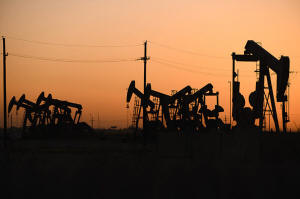What's next for oil and gas prices as Middle East tensions heat up?
 Send a link to a friend
Send a link to a friend
 [October 05, 2024] Associated
Press [October 05, 2024] Associated
Press
Oil prices climbed this week as tensions in the Middle East escalated.
Iran launched missiles at Israel and the Israelis threatened
retaliation, raising the possibility of a disruption to the flow of oil
from the region. A jump in oil prices automatically spurs fear of a
spike in gas prices, but experts see reasons that may not happen.
Here's a look at the current situation and the outlook for oil and gas
prices:
Familiar tensions, different times
Oil prices rose than $6 per barrel (5.47 euros) this week and prices at
the pump moved higher as well. The average price for a gallon of gas
rose 5 cents from last week. Any major escalation of tensions in the
Middle East conjures up memories of the oil embargo that followed the
start of the Yom Kippur war in 1973, which quadrupled oil prices.
However, the global supply of oil has been altered radically since the
1970s, with the U.S. becoming the world's largest oil producer. Months
of war between Israel and Hamas and Hezbollah, two Iranian proxies, did
little to boost prices for OPEC and its 12 oil-producing nations. Only
the possibility of a direct confrontation between Israel and Iran moved
the needle.
Gasoline prices are up, but cheaper than last year
U.S. gas prices typically rise along with crude because the price of oil
makes up half the cost of a gallon of gasoline.
The national average for gas has risen to about $3.18 per gallon,
according to AAA. But that’s still 13 cents less than a month ago and 60
cents less than a year ago. The record national average high of $5 per
gallon was reached in June 2022.

“Despite the threat of war and a hurricane season that is still
percolating, domestic gasoline prices are edging lower,” AAA
spokesperson Andrew Gross said in a statement on Thursday. “There are
now 18 states east of the Rockies with averages below $3 a gallon."
AAA also estimates that approximately 1.2 million of its members live in
households with one or more electric vehicles. The organization believes
that tepid gas demand and low oil costs will likely keep prices at gas
pumps sliding.
It's the fundamentals
The long-term expectation is for oil prices to move lower, not higher.
That's because the balance between supply and demand has tilted toward
supply, a dynamic that typically weighs on oil prices.
In its most recent update on the energy markets, the International
Energy Agency said demand for oil in the first half of this year rose by
the smallest amount since 2020. Meanwhile, supplies have continued to
increase and the OPEC+ alliance, made up of members of the producers
cartel and allied countries including Russia, has said it plans to
release more oil into the market starting in December.
[to top of second column] |

An array of pumpjacks operate near the site of a new oil and gas
well being drilled April 8, 2022 in Midland, Texas. (Eli
Hartman/Odessa American via AP, File)
 “Geopolitical tensions have soared
of late and yet fundamentals seem to be moving in the opposite
direction with Iranian oil exports trending close to the highest
level in years,” Barclays analyst Amarpreet Singh said in a note to
clients. “The jury is out on the primary driver of the geopolitical
drift, but it warrants caution against taking a strong view on a
sustained disruption.”
State of Iran's oil sector
The country produces 3.99 million barrels per day, which is 4% of
the world total. By comparison, Saudi Arabia produces about 9
million barrels a day.
Despite sanctions imposed by the West that have hampered production
and export levels, Iran continues to find ways to maintain its oil
sector, sometimes using creative methods like blending and
re-labeling oil for sale to markets like China. As of the middle of
this year, Iran was exporting about 2 million barrels of oil a day,
up from 500,000 in 2020 but below the 2.5 million barrels it
exported each day in 2018.
Export terminals like Kharg Island in the Persian Gulf could be a
target for an Israeli strike. They play a key role in shipping crude
oil abroad, primarily to Asian countries, including China.
Oil prices rose Thursday after President Joe Biden said U.S. and
Israeli officials were discussing a possible Israeli strike on
Iranian oil facilities. On Friday, Biden said the exact nature of
any retaliatory action by Israel was “under discussion.” But he
added, "I think if I were in their shoes, I’d be thinking about
other alternatives than striking oil fields.”
What's next for oil prices?
Tom Kloza, global head of energy analysis with the Oil Price
Information Service, believes oil prices are approaching a top, with
U.S. crude oil at $74.38 and Brent crude, the international
benchmark, at $78.05. “Perhaps Brent may have a cup of coffee at $80
a barrel or higher,” he wrote in an email, but the long-term outlook
is for lower prices.
“As soon as things calm down, oil traders will concentrate on 2025
and 2025 looks very problematic for high prices with supply almost
certainly outpacing demand by 500,000 to 1 million barrels a day,”
Kloza said.
All contents © copyright 2024 Associated Press. All rights reserved
 |